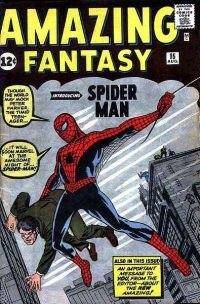The modern-day superhero may have started with Superman in 1938. But the superhero as we know him—the first to be truly considered a “character” in a literary sense—was unveiled in 1962, in the most unlikely circumstances, when a radioactive spider bit a shy, bookworm of a teenager in the pages of Marvel Comics’ Amazing Fantasy #15.

FIRST appearance of Spider-Man
That was when Spider-Man was born.
Spider-Man was a marked departure from teens who had preceded him in the comic book pages. He was, in fact, not a man, but a boy—or a young man, at least. Until 1962, most comic-book teenagers were sidekicks to their grown-up counterparts—Robin to the adult Batman, or Bucky to Captain America. (Unlike the Bucky made famous in the recent Captain America movies, the Bucky of the early Cap comics was a young teen, who, for some reason, was seen fit to be sent overseas to beat up Nazis.) These characters were created in an attempt to give young readers someone with whom to identify.
But in casting about for a new twist on the superhero story, Marvel Comics editor and writer Stan Lee (who created Spider-Man along with the brilliant artist Steve Ditko) wanted to make the main character himself the teenager. And he didn’t stop there. He didn’t want simply to bestow upon Peter Parker the super-powers that would make him every teen’s favorite hero. He also wanted to burden Parker with all the trappings of the contemporary teenager. This hero wouldn’t just have to deliver the bad guys to the cops. He would also have to get his homework in on time the next morning.
That’s when things got interesting.
For arguably the first time in comic book history, the hero had an inner dialogue that made him a real person to millions of readers. He had acne. He worried about the big test. He pined for girls he could never have. By night, he chased down muggers and thieves. By day, he was the class nerd, showed up by the campus football hero.
It was a milestone in comic book history. Spider-Man, a hero so bizarre that Lee had to personally convince his publisher to print him in the first place, was an instant hit with teenagers across the country—teenagers who instantly recognized Spider-Man as one of them.
The harder it was for Peter Parker to live his double life and keep the streets of New York City safe, the more his fans loved him. And it was always hard for Peter. In fact, while it was the bite of a radioactive spider that gave him his super-powers, it was a harsh life lesson that turned him into a superhero. In a moment of bitter callousness, Peter fails to stop a crook in the commission of a crime. Later, that criminal kills Peter’s beloved Uncle Ben. From that moment on, Peter vows to use his powers not for personal gain, but for the greater good. Thus, Spider-Man was born. And despite the hardships it imposed upon him personally, despite having been branded a menace by the New York Daily Bugle (and its perpetually grumpy publisher, J. Jonah Jameson), Peter never fails to fight the good fight.
It wouldn’t be the first time that a youthful literary character would be forced to follow his conscience in the face of social pressure to do otherwise. Seventy-eight years before Spider-Man spun his first web, another young hero would buck popular convention to do what he thought was right. In the pages of what many consider to be the first great American novel, young Huckleberry Finn had the moral fortitude to oppose social norms, to deny everything he had ever been taught, and to risk the threat of eternal damnation itself to rescue his friend Jim from a lifetime of slavery. One wonders how American literature might have changed had Samuel Clemens thought of giving young Huck superpowers.
Indeed, Spider-Man may even have a smattering of the 20th century’s most legendary fictional teen in him as well. In 1951, J.D. Salinger published what might be the quintessential novel of teenage inner conflict and angst. Picturing himself to be a Catcher in the Rye (as opposed to a web-slinger in the sky), Holden Caulfield imagined saving innocents from the dangers of the world, despite his personal conflicts and tribulations. Awkward with women, questioning authority, without a clue in the world as to what his future might hold—Holden was a set of tights and a lab accident away from becoming a modern comic book hero himself.
It’s in the tradition of these immortal literary characters that Spider-Man has left his mark not only on the world of comic books, but on modern popular culture itself. Today, Spidey is more than just the most recognizable hero in the Marvel pantheon. He’s the first character to strike a chord in a literary sense with what would become generations of fans. Sure, at one time or another, we all wanted to be Superman, or Wonder Woman, or some other god-like creature who could streak across the heavens and perform spectacular feats of wonder. But deep down, we knew we were Spider-Man—the hero who, after a long night of fighting crime, would actually have to put his tights in the laundry. Like the lives of the great literary characters who preceded him, Peter Parker’s life was our own, and it was, and continues to be, a magnificent open book.
Image credits:
http://marvel.com/comics/issue/16926/amazing_fantasy_1962_15



